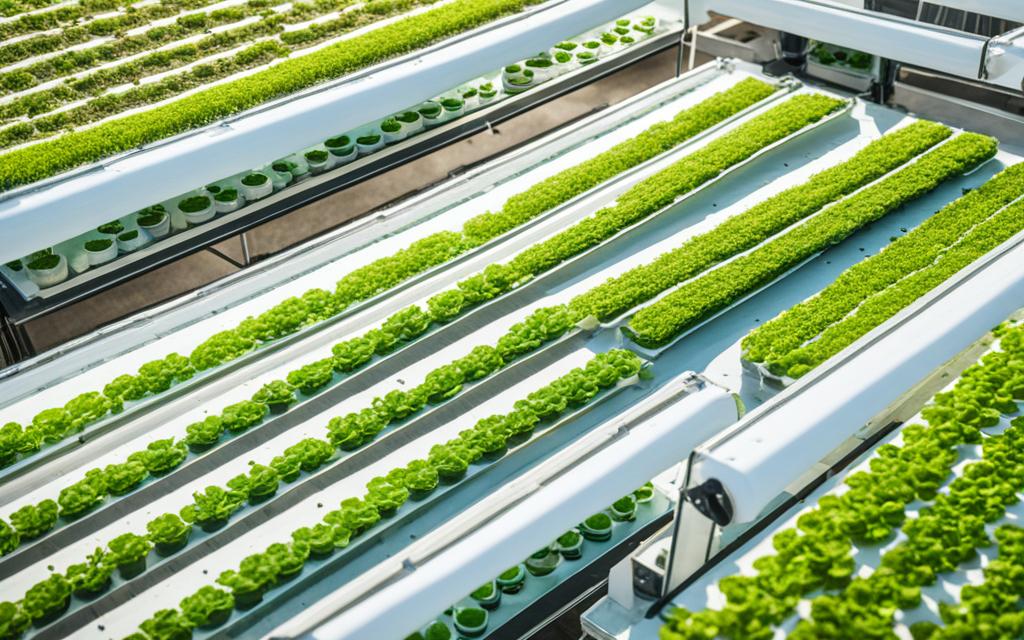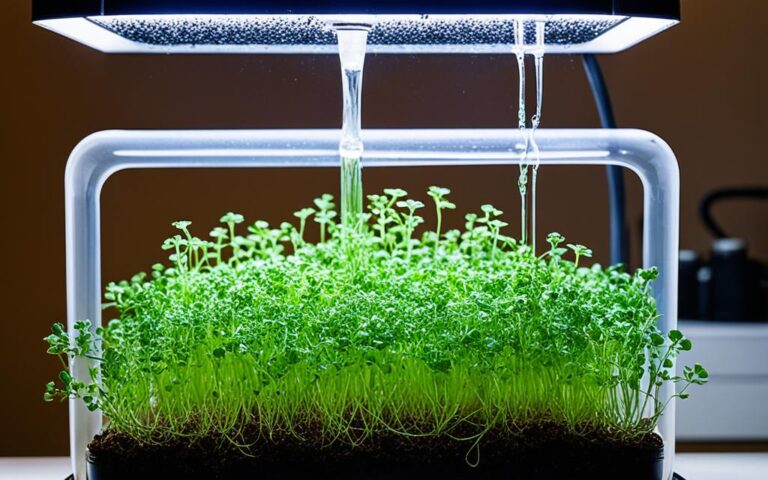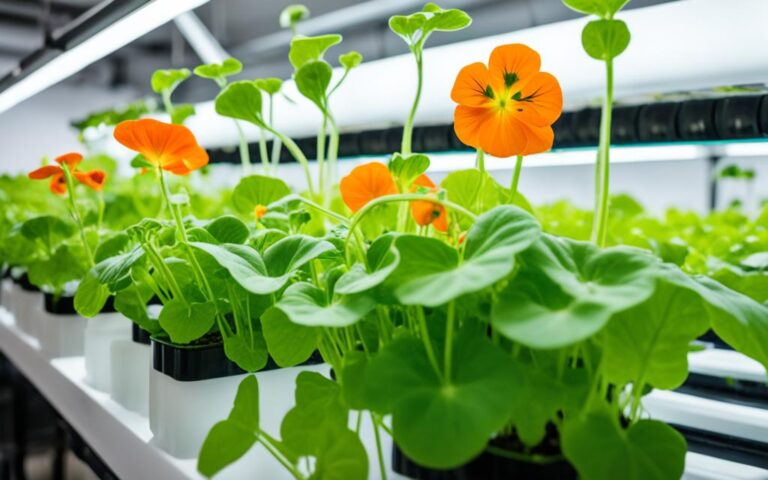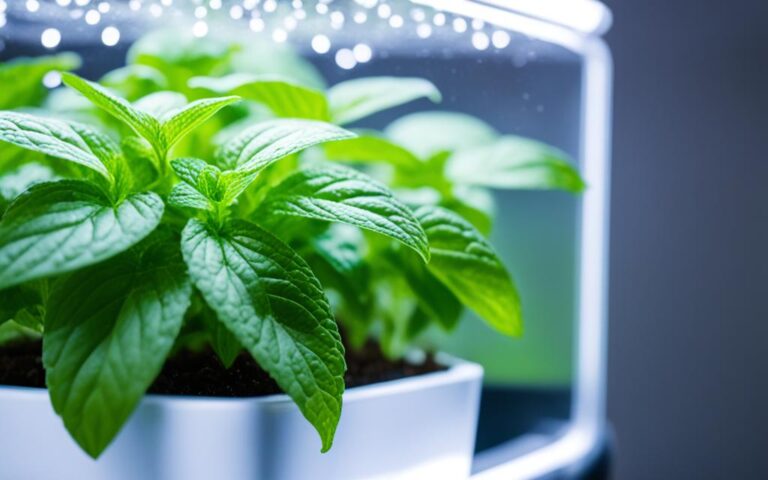Ultimate Guide to Hydroponic Microgreens Varieties
Did you know that just one square foot of hydroponic microgreens can yield up to 4 pounds of nutrient-dense produce? This fact shows how powerful hydroponic systems are for growing food. They are becoming more popular with both home and commercial growers.
This guide explores the world of hydroponic microgreens. It offers deep info on many microgreen types that do well with hydroponics and grow lights. You’ll learn why growing microgreens hydroponically is good, how to pick the best ones, and how to set up a hydroponic system. You’ll also get tips on managing nutrients and growing conditions to get the best yield and quality.
Key Takeaways
- Hydroponic microgreens can yield up to 4 pounds per square foot, making them a highly efficient and productive crop.
- This guide covers a wide range of hydroponic microgreen varieties, their benefits, and how to select the best ones for your growing needs.
- Readers will learn the essential steps for setting up a hydroponic system, managing nutrients, and optimizing growing conditions to achieve maximum yield and quality.
- The article also addresses common pests and diseases, troubleshooting tips, and strategies for maximizing the productivity and nutritional value of hydroponic microgreens.
- With a focus on informative and practical content, this guide is a valuable resource for both novice and experienced growers interested in exploring the world of hydroponic microgreens.
Introduction to Hydroponic Microgreens
Microgreens are young, tender shoots of edible plants harvested in 1-2 weeks after germination. They are loved for their strong flavors, bright colors, and high nutritional value. Chefs, home gardeners, and those who care about health enjoy them.
What are Microgreens?
Microgreens are small versions of leafy greens, herbs, and vegetables. They are full of vitamins, minerals, and antioxidants. Harvested early, when the first true leaves appear, they offer a nutrient-rich addition to meals.
Benefits of Growing Microgreens Hydroponically
Growing microgreens hydroponically has many benefits. Hydroponics lets you control nutrients, pH levels, and the environment. This means faster growth, more produce, and crops all year.
Using grow lights, you can grow microgreens indoors. This ensures a steady supply of fresh greens, no matter the season or outdoor conditions.
| Benefit | Explanation |
|---|---|
| Faster Growth | Hydroponic systems deliver nutrients directly to the plant’s roots, enabling faster and more efficient growth compared to soil-based cultivation. |
| Higher Yields | The controlled environment and precise nutrient management in hydroponic systems lead to increased productivity and higher yields per square foot. |
| Year-round Production | By growing microgreens indoors with the aid of grow lights, hydroponic growers can produce a consistent supply of fresh greens throughout the year, regardless of outdoor conditions. |
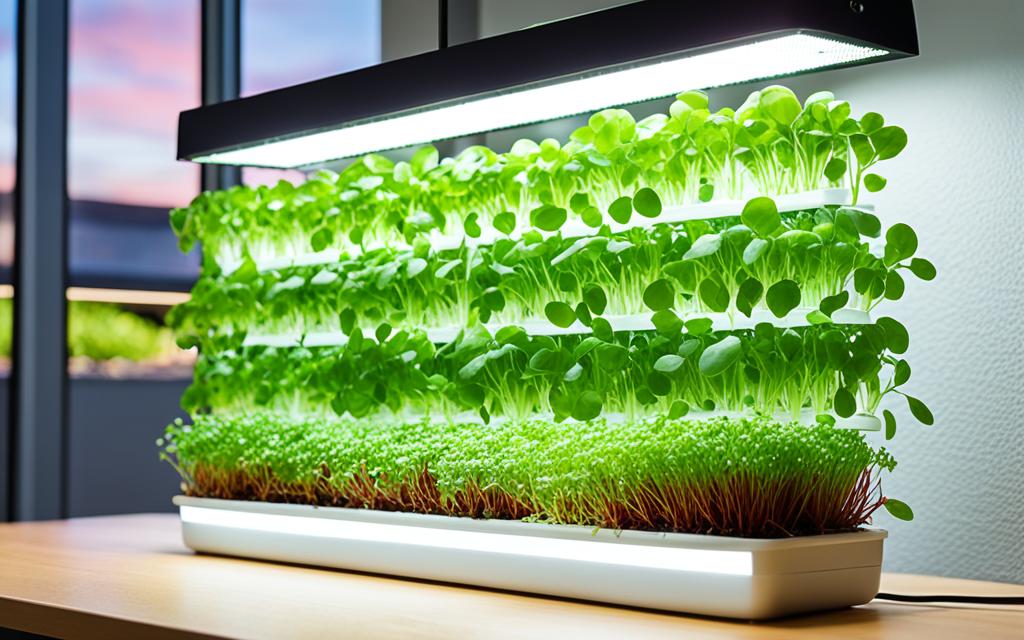
“Hydroponic microgreens are a game-changer for chefs and health-conscious consumers who desire a steady supply of fresh, nutritious greens year-round.”
Selecting Hydroponic Microgreen Varieties
Choosing the right microgreens for hydroponic systems is key to great results. There are many microgreen types that do well with hydroponics and extra light. Favorites include pea shoots, sunflower shoots, radish, broccoli, red cabbage, basil, kale, cilantro, and arugula. Each type brings unique tastes, textures, and nutrients to the table, making them versatile for different dishes.
Popular Microgreen Varieties
- Pea Shoots: Tender, sweet, and packed with nutrients like vitamin C, iron, and protein.
- Sunflower Shoots: Crunchy, nutty flavor and high in vitamins A, C, and E.
- Radish: Spicy, peppery notes and rich in vitamins and minerals.
- Broccoli: Mild, earthy flavor and a good source of sulforaphane.
- Red Cabbage: Vibrant color, sweet-and-sour taste, and high in antioxidants.
- Basil: Aromatic, sweet, and herbal notes, perfect for culinary applications.
- Kale: Nutrient-dense, with a slightly bitter and earthy flavor.
- Cilantro: Fresh, citrusy, and a key ingredient in many global cuisines.
- Arugula: Peppery, bold flavor and rich in phytochemicals.
Factors to Consider When Choosing Varieties
When picking microgreens for hydroponics, think about growth speed, light needs, nutrient requirements, and system compatibility. Knowing what each variety needs ensures the best growth and yield. Also, consider how you plan to use the microgreens, like for garnishes, salads, or adding flavor to dishes.
| Microgreen Variety | Growth Rate | Light Requirements | Nutrient Needs | Ideal Use |
|---|---|---|---|---|
| Pea Shoots | Fast | Moderate | High | Salads, Garnishes |
| Sunflower Shoots | Fast | High | Moderate | Salad Mixes, Ingredient Enhancement |
| Radish | Moderate | Moderate | High | Garnishes, Salads |
| Broccoli | Moderate | Moderate | High | Salad Mixes, Ingredient Enhancement |
| Red Cabbage | Moderate | Moderate | Moderate | Salads, Garnishes |
By looking at these factors, growers can pick the best microgreens for their setup and needs. This ensures a good harvest and a variety of tasty options for cooking.
Setting Up a Hydroponic System for Microgreens
Setting up a hydroponic system for microgreens requires careful planning and choosing the right equipment. You can pick from methods like nutrient film technique (NFT), deep water culture (DWC), or ebb and flow systems. Each method has its own benefits and things to consider.
The setup must have enough space, good lighting, and a controlled environment for microgreens. Here are the main steps to think about when setting up a hydroponic system for microgreens:
- Choose the Hydroponic Method: Look at the pros and cons of different systems like NFT, DWC, or ebb and flow. Pick the best one for your microgreen needs.
- Ensure Adequate Space: Make sure you have enough space for your hydroponic setup. This space should allow for good air flow and easy access during growth.
- Provide Appropriate Lighting: Choose the right lighting, like natural sunlight, LED, or a mix, to give your microgreens the best light.
- Maintain a Controlled Environment: Control temperature, humidity, and air flow to make the perfect growing conditions for your microgreens.
- Invest in Quality Equipment: Pick reliable and efficient hydroponic gear, like pumps, grow trays, and nutrient systems, to help your microgreens grow well.
By thinking about these key points, you can set up a hydroponic system that’s perfect for growing microgreens.
“A well-designed hydroponic system can significantly improve the yield and quality of your microgreens.”
Nutrient Management for Hydroponic Microgreens
Growing hydroponic microgreens needs a fine balance of nutrients. Microgreens need a mix of essential nutrients for the best growth and development. Important nutrients are nitrogen, phosphorus, potassium, calcium, magnesium, and many micronutrients. It’s important to check and adjust the nutrient mix so plants get what they need.
Essential Nutrients
Microgreens need various nutrients for quick growth and development. These include:
- Nitrogen (N) for healthy leaves and stems
- Phosphorus (P) for roots and energy
- Potassium (K) for fighting stress and diseases
- Calcium (Ca) for strong cell walls and plant structure
- Magnesium (Mg) for making chlorophyll and photosynthesis
- Micronutrients like iron, boron, and zinc for metabolism
Preparing Nutrient Solutions
To make the nutrient solution for hydroponic microgreens, mix a concentrated fertilizer with water and adjust the pH to 5.5 to 6.5. You can use store-bought hydroponic nutrients or make your own mix for the microgreens you’re growing. It’s important to test and adjust the nutrients often to keep them at the right levels for healthy plants.
“Precise nutrient management is the key to unlocking the full potential of hydroponic microgreens.”
Growing Conditions for Hydroponic Microgreens
To grow healthy hydroponic microgreens, you need to control the growing environment well. This means managing light and temperature and humidity levels carefully.
Light Requirements
Microgreens need specific lighting to grow well. They need a mix of blue and red light. Growers use high-intensity grow lights or LED panels for 12-16 hours a day. This helps them grow and develop fully.
- Blue wavelengths (400-500 nm) promote leaf and stem development
- Red wavelengths (600-700 nm) enhance root growth and overall plant vigor
- A combination of both blue and red light ensures well-rounded plant development
Temperature and Humidity
Light is not the only thing microgreens need. The right temperature and humidity are also key. The best temperature is between 65°F and 75°F (18°C to 24°C). Humidity should be 40% to 60%.
Keeping an eye on these levels helps avoid problems like mold, disease, or slow growth.
“Balancing the light, temperature, and humidity in a hydroponic microgreen system is crucial for achieving optimal growth and quality.”
Hydroponic Microgreens (various types)
The world of hydroponic microgreens is full of vibrant and tasty options. From the delicate pea shoots to the strong sunflower sprouts, each type has its own needs and tastes. Let’s explore these hydroponic wonders and see what they can offer.
Pea Shoots: A Delicate Delight
Pea shoots do well in hydroponics, needing the right amount of nutrients and lots of light. They take about 5-7 days to germinate and are ready to harvest in 10-14 days. These greens taste sweet and fresh, making them perfect for many dishes.
Sunflower Shoots: Vibrant and Robust
Sunflower shoots stand out in the hydroponic microgreen world. They grow fast and are full of nutrients, making them a favorite. They germinate in 3-5 days and are ready in 12-16 days. These shoots have a nutty taste and a crunchy texture.
Radish Microgreens: A Peppery Punch
Radish microgreens do great in hydroponics, needing the right nutrients and plenty of light. They germinate in 5-7 days and are ready in 10-14 days. These greens add a peppery flavor to salads and garnishes.
- Broccoli microgreens: Rich in vitamins and minerals, these microgreens offer a delicate, earthy flavor with a touch of bitterness.
- Red cabbage microgreens: Vibrant in color and packed with antioxidants, these microgreens lend a slightly sweet and peppery taste to dishes.
- Basil microgreens: Fragrant and flavorful, these microgreens are a classic choice, offering a fresh, herbal note to enhance a variety of culinary creations.
From the bold kale to the aromatic cilantro and the peppery arugula, hydroponic microgreens offer a world of flavors and textures. By learning about each variety’s needs, you can grow a microgreen garden that adds color and flavor to your cooking.
Harvesting and Storage
Finding the best time to harvest hydroponic microgreens is key for their freshness, taste, and nutrient levels. Growers should watch the microgreens grow and pick them when the first true leaves appear. This is usually within 7-14 days after planting the seeds. Using clean scissors or knives to cut the greens right above the growing medium helps keep them in good condition.
Optimal Harvest Time
Hydroponic microgreens are at their best in 7-14 days after planting. It’s important to watch their growth and pick them when the first true leaves come out. This is when they have the most vitamins, minerals, and other good stuff.
Proper Storage Techniques
Storing hydroponic microgreens right after picking is key to keeping them fresh. Rinse them gently, dry them, and put them in the fridge in a sealed bag or container. Keeping them in a cool place, between 35°F and 40°F (2°C to 4°C), and keeping air away helps them last longer. This means you can enjoy them for more days and waste less.
By harvesting and storing hydroponic microgreens the right way, growers can keep them fresh, tasty, and full of nutrients. This makes sure they give their customers or themselves the best product possible.
Common Pests and Diseases
Growing microgreens hydroponically can be tricky because of pests and diseases. Growers might face problems like aphids, fungus gnats, powdery mildew, or root rot. These issues can harm plant health and lower yields. It’s important to take steps to prevent these problems for a successful hydroponic microgreen operation.
Identifying and Addressing Common Pests
Aphids are a big problem in hydroponic microgreens. These tiny insects suck sap from plants and can spread fast. To control aphids, check your plants often and use organic soaps or neem oil.
Fungus gnats are another issue, especially in moist systems. These flies lay eggs in the soil, and their larvae harm plant roots. Keep your system clean, use dry media, and try beneficial nematodes or sticky traps to fight fungus gnats.
Preventing and Treating Diseases
Powdery mildew often affects hydroponic microgreens. This disease looks like white powder on leaves and stems. It can stop plants from making food. To fight powdery mildew, improve air flow, lower humidity, and use organic fungicides like potassium bicarbonate.
Root rot is another disease to watch out for. It’s caused by different pathogens and can make plants wilt, turn color wrong, and die. Keep your system clean, check the water quality, and pick disease-resistant plants to prevent root rot.
By being careful and using organic or biological controls, growers can keep pests and diseases away from their hydroponic microgreens. This ensures the health and productivity of their crops over time.
Troubleshooting Tips
Growing hydroponic microgreens is rewarding but comes with challenges. It’s important to spot and fix nutrient and environmental issues. This keeps your microgreen crop healthy and strong.
Nutrient Deficiencies
Check your microgreens often for signs of nutrient problems, like color changes, slow growth, or poor health. Knowing what nutrients each type of microgreen needs helps you fix any issues. Adjusting the nutrient solution or adding supplements can help your plants do well.
Environmental Factors
Pay attention to environmental factors that affect your hydroponic microgreens too. Things like temperature changes, not enough light, wrong humidity, or air circulation issues can hurt plant growth. Fixing these problems helps your hydroponic system work better.
Keep an eye on your hydroponic microgreens and act fast if you see problems. This way, you can beat common challenges and get a great crop. Regular checks and quick fixes are key to growing hydroponic microgreens successfully.
Maximizing Yield and Quality
Using a strategic crop rotation plan boosts the yield and quality of hydroponic microgreens. By switching between different microgreen types, growers keep the soil healthy. This also stops pests and diseases from building up and makes resources go further. Planning the order of crops ensures a steady supply of diverse, nutrient-packed microgreens all year.
Crop Rotation
Crop rotation is crucial for better hydroponic microgreen farming. By growing various microgreen species one after the other, growers can:
- Keep the soil fertile and stop nutrients from running out
- Break the life cycle of pests and diseases, lowering the chance of outbreaks
- Offer a wider range of microgreens for harvest and sale
A good crop rotation plan looks at each microgreen’s nutrient needs, growth style, and pest or disease risks.
Optimizing Growing Conditions
For top yields and quality in hydroponic microgreens, it’s key to keep improving growing conditions. Growers should adjust things like light, nutrients, temperature, humidity, and air flow for each microgreen type. Checking on plant health and tweaking as needed unlocks the full potential of hydroponic microgreens.
| Optimizing Factor | Importance for Microgreen Yield and Quality |
|---|---|
| Light Intensity and Spectrum | Ensures optimal photosynthesis and growth |
| Nutrient Solution Composition | Provides the necessary macro- and micronutrients for healthy plant development |
| Temperature and Humidity | Maintains the ideal growing environment for each microgreen variety |
| Air Circulation | Promotes uniform distribution of light, heat, and CO2 for even growth |
By using a strategic crop rotation plan and always improving growing conditions, hydroponic microgreen growers can get the most out of their crops. This ensures they produce high-quality, nutrient-rich microgreens.
Conclusion
This guide has taken us on a journey through the world of hydroponic microgreens. It has given us the knowledge and tools to grow many types of nutrient-rich, tasty microgreens all year. We learned how to meet the needs of different microgreens, set up the right hydroponic system, and manage nutrients and conditions.
We also learned how to harvest and store them properly. This knowledge lets growers make the most of this healthy and versatile crop. Whether you’re growing for yourself, for cooking, or for a business, this guide has given you the tools to succeed.
Now, you’re ready to start a hydroponic microgreen operation. You’ll be able to provide fresh, tasty, and nutritious greens for your meals or market. With the advice from this guide, the future of growing hydroponic microgreens looks bright. It’s a sustainable and rewarding way to add these super greens to your diet and cooking.
